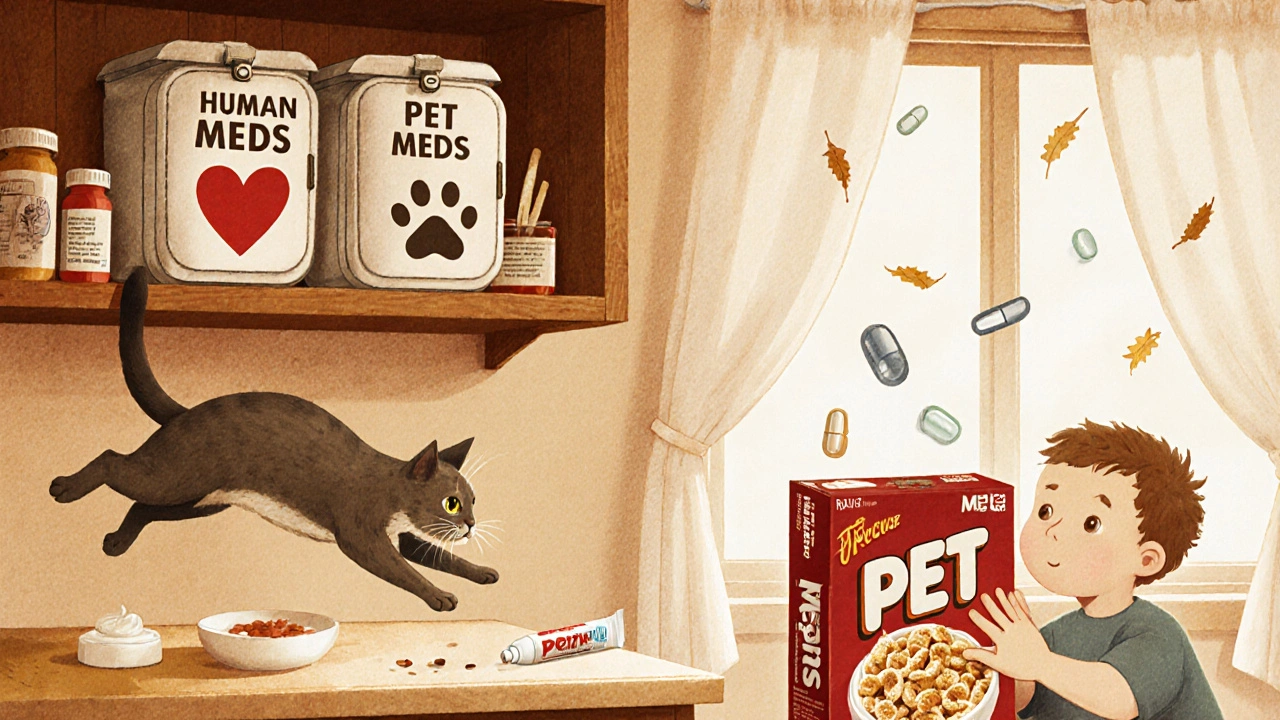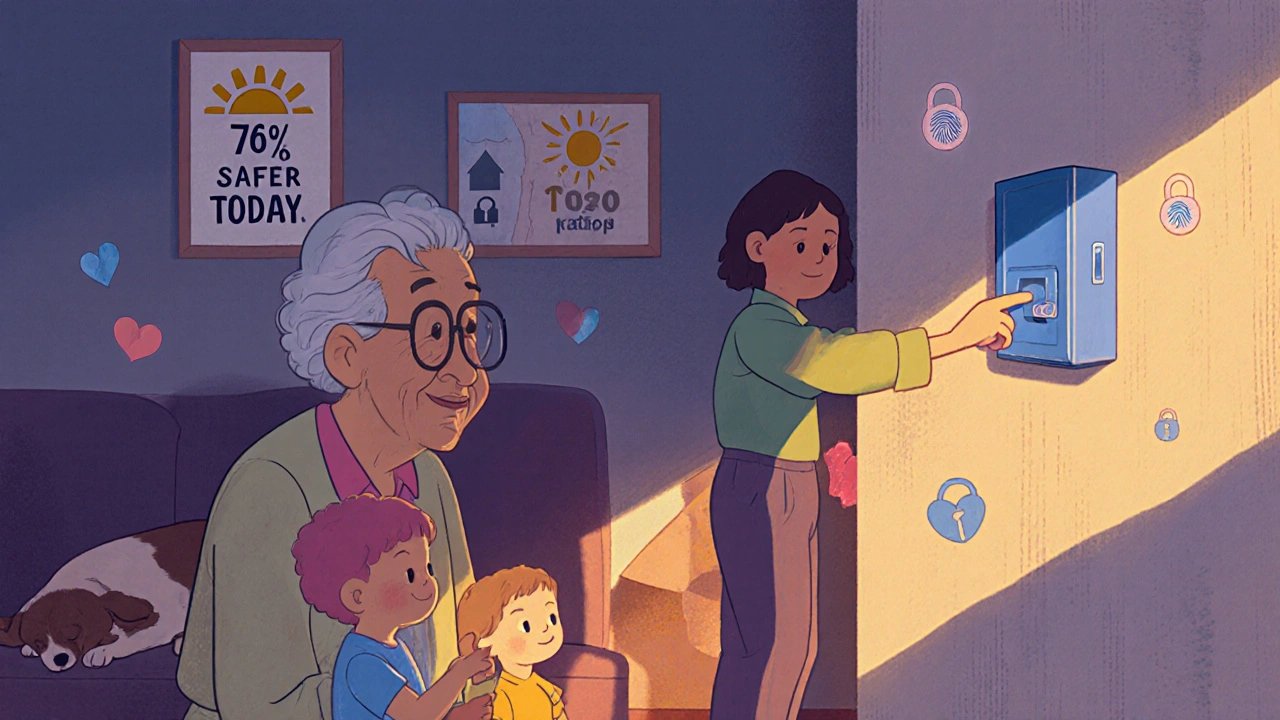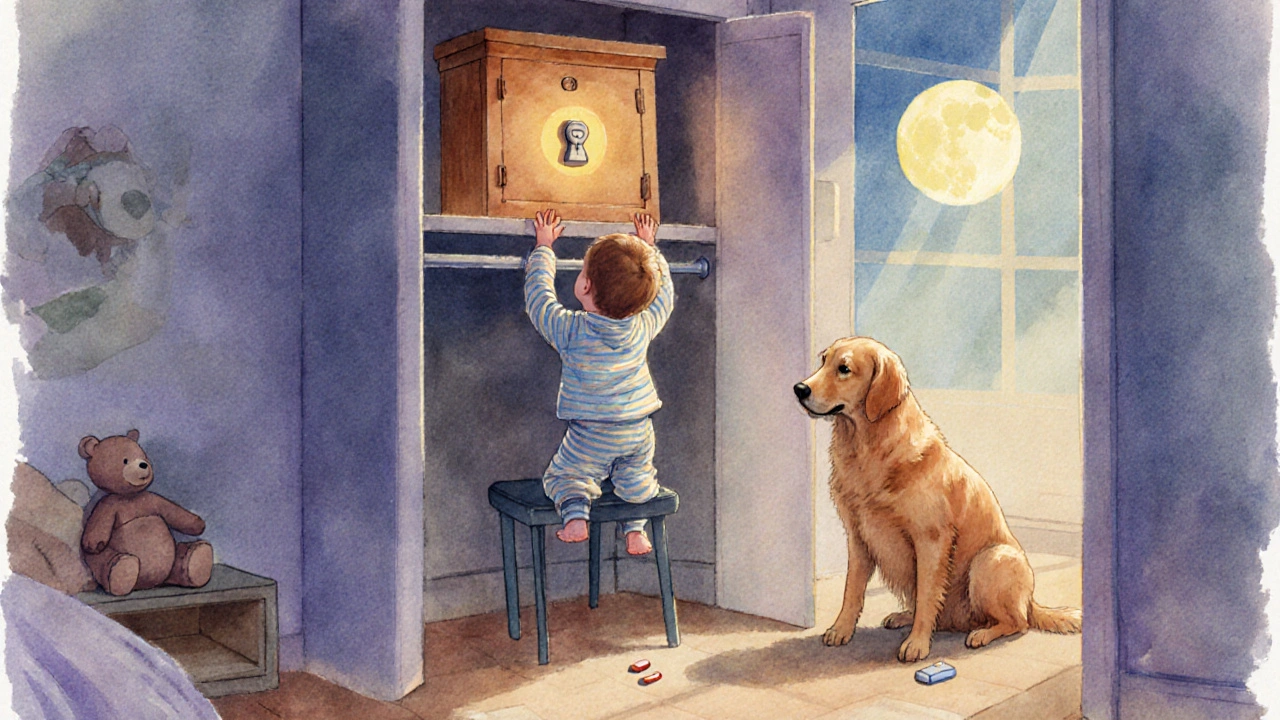Every year, tens of thousands of children and pets end up in emergency rooms because they got into medications that weren’t stored properly. It’s not because parents are careless-it’s because most people don’t realize how easy it is for a toddler to climb onto a countertop, or how a dog can chew through a pill bottle in under two minutes. The truth is, child-resistant packaging isn’t enough. Neither is keeping meds on a shelf out of sight. If you have kids or pets, you need a real safety plan-and it’s simpler than you think.
Why Your Medicine Cabinet Isn’t Safe
Most families store medications in the bathroom. It’s convenient. But bathrooms are humid, hot, and full of temptation. A child who’s learning to climb can reach a sink. A dog sniffing around for treats might find a flavored heartworm pill that tastes like bacon. The CDC says 80% of accidental poisonings happen when kids find meds on countertops, in purses, or nightstands-not in locked cabinets. Even worse, 45% of pet medications are flavored to make them palatable for animals, which makes them extra appealing to children. A 5mL dose of veterinary ivermectin can be lethal to a toddler. That’s not a hypothetical risk. It’s a documented tragedy.The 4 Rules of Safe Medication Storage
There are four non-negotiable rules if you want to keep your family safe:- Lock it up. Child-resistant caps are only 50-80% effective. A locked box is 92% effective, according to Nationwide Children’s Hospital. You don’t need a fancy safe. A $25 wall-mounted lockbox from a hardware store works. Gun safes, toolboxes, or even a locked drawer in a high cabinet are fine-as long as the key or combination is kept away from children.
- Keep it high. Children as young as 18 months can climb 3-foot furniture. Store everything at least 4 feet off the floor. Some experts recommend 5 feet. Either way, if it’s within climbing distance, it’s not safe.
- Keep it dry and cool. Heat and moisture ruin medicine. The FDA says 70% of human medications need to be stored between 68-77°F (20-25°C). Humidity degrades 40% of pills within 30 days. Don’t store meds in the bathroom or above the stove. A kitchen pantry, bedroom dresser, or closet shelf away from windows is ideal.
- Keep human and pet meds separate. This is the most overlooked rule. Storing them together increases mix-up risk by 4.7 times. A dog’s flea treatment might look like a child’s allergy pill. A cat can die from touching human 5-fluorouracil cream. Keep pet meds in a different room, or at least a different locked container. The American Academy of Pediatrics now recommends keeping them at least 15 feet apart.
What About Pet Medications?
Veterinary drugs are a hidden danger. They’re often sweetened, shaped like treats, or come in paste form that’s easy to squeeze out. Since 2018, over 200 dogs have died from ingesting dewormer paste meant for horses. That paste tastes like peanut butter. Dogs can open standard pill bottles in under two minutes. Cats are even more vulnerable-just 0.5mg of human 5-fluorouracil cream can kill them. And here’s the kicker: 78% of pet poisonings happen because owners store vet meds in the bathroom medicine cabinet. That’s the same place you keep your insulin, blood pressure pills, and painkillers. Don’t do it.
What to Do With Old or Unused Medications
Don’t flush them. Don’t toss them in the trash. Don’t leave them in a drawer for "someday." The FDA warns that flushing meds pollutes waterways, and throwing them out increases risk of accidental ingestion or misuse. The safest option? Use a drug take-back program. In 2024, the DEA expanded National Take Back Day to over 11,000 locations nationwide-pharmacies, police stations, and hospitals. If you can’t get to one, mix pills with coffee grounds or cat litter, seal them in a plastic bag, and throw them in the trash. Remove labels first. For liquids, pour them into a sealable container with absorbent material like sawdust or dirt before disposal.Common Mistakes (And How to Fix Them)
Most families think they’re doing fine. But the data says otherwise:- Mistake: Leaving meds on the nightstand for "easy access." Fix: Move them to a locked box before bedtime.
- Mistake: Transferring pills to unlabeled containers. Fix: Keep everything in original bottles. Labels have dosage, expiration, and warnings.
- Mistake: Storing pet meds next to food bowls. Fix: Put them in a high cabinet, away from the kitchen.
- Mistake: Assuming "child-resistant" means "child-proof." Fix: Always lock it. Even if the cap is hard to open, a child can learn to twist it open with practice.
What Works: Real Solutions From Real Families
Parents who’ve had close calls don’t guess-they act. One family in Brisbane started using a small gun safe ($45) in their bedroom closet. They keep all human and pet meds inside, with a key on a lanyard around their neck. No more accidents. Another family installed a timed lockbox on the kitchen wall. It opens only at 7 a.m. and 7 p.m.-when doses are given. Compliance jumped from 45% to 92%. A grandmother with arthritis uses a low lockbox with a thumbprint opener so she can reach it easily, but her grandchildren can’t. These aren’t expensive fixes. They’re smart habits.
Who’s at Highest Risk?
It’s not just toddlers. Pets are just as vulnerable. Dogs and cats are 10 times more sensitive to certain human drugs than we are. Even a single ibuprofen tablet can cause kidney failure in a dog. Children under 5 are the most common victims of accidental ingestion-but teens are at risk too, especially with opioid painkillers or ADHD meds. Low-income households are less likely to use locked storage-only 18% do, compared to 47% in higher-income homes. That’s not about negligence. It’s about access. A $150 safe is a luxury when you’re choosing between rent and groceries. That’s why community programs and pharmacies need to offer low-cost lockboxes. Some clinics in Queensland now give them away for free with prescriptions.What’s Changing in 2025
The FDA now requires all new veterinary medications to include pictograms on the label showing where to store them-like a padlock or a shelf. By 2026, 12% of households will use smart pill dispensers that lock after doses and send alerts if someone tries to open them. But technology won’t replace behavior. The CDC says the single biggest factor in preventing poisonings is consistent, locked storage. No app, no sensor, no smart bottle can replace a parent who remembers to lock the box.Start Today
You don’t need to overhaul your home. Just pick one thing to fix today:- Find all medications in your house-human and pet.
- Put them in one locked container.
- Move it to a high, dry spot-not the bathroom.
- Keep the key or code where only adults can reach it.
Can child-resistant caps alone protect my kids?
No. Child-resistant caps are designed to slow down curious children, not stop them. Testing by the Consumer Product Safety Commission shows they prevent only 50-80% of attempts. A determined toddler can figure them out in minutes. Locked storage is the only reliable method.
Is it safe to store pet and human meds together?
No. Mixing them increases the risk of accidental ingestion by 4.7 times. Pet meds are often flavored to appeal to animals, making them tempting to children. Heartworm preventatives, flea treatments, and dewormers can be deadly if taken by a child. Always store them in separate locked containers, ideally in different rooms.
Where’s the best place to store medications at home?
The safest spot is a locked box on a high shelf in a dry, cool area like a bedroom closet or kitchen pantry. Avoid bathrooms, windowsills, and nightstands. Humidity and heat degrade medicine, and those locations are easiest for kids and pets to reach.
What should I do with expired or unused medications?
Use a drug take-back program. The DEA’s National Take Back Day has over 11,000 collection sites across the U.S. If that’s not available, mix pills with coffee grounds or cat litter, seal them in a plastic bag, and throw them in the trash. Remove labels first. Never flush them.
Are there affordable storage options for low-income families?
Yes. A basic wall-mounted lockbox costs as little as $25. Many pharmacies, clinics, and community health centers now offer free lockboxes with prescriptions. Even an unused toolbox or locked drawer can work if it’s out of reach and secured with a padlock.


Comments
Esperanza Decor
I never realized how dangerous the bathroom medicine cabinet was until my neighbor’s dog got into some heartworm pills. Two hours later, he was in critical care. We moved everything to a locked box in the closet after that. No more excuses. It’s not about being paranoid-it’s about being smart.
Even my 2-year-old figured out how to open the child-resistant cap on my ibuprofen. I thought I was safe. I wasn’t.
November 14, 2025 at 12:45
dace yates
My mom used to keep all her meds on the nightstand because she had arthritis. I used to think it was just her habit. Then I found out she had 17 different bottles within arm’s reach of my nephew’s crib. I didn’t say anything-until he nearly swallowed a fentanyl patch. Now she uses a lockbox. I wish I’d spoken up sooner.
November 15, 2025 at 01:37
Danae Miley
The CDC data is clear: 80% of pediatric poisonings occur because medications are stored within climbing distance. Child-resistant caps are a marketing gimmick, not a safety feature. If you’re still relying on them, you’re gambling with your child’s life. The 4 rules outlined here aren’t suggestions-they’re non-negotiable. Period.
Also, pet meds are not toys. I’ve seen a 10-pound cat die from licking human 5-FU cream off a finger. This isn’t hypothetical. It’s a preventable autopsy.
November 15, 2025 at 13:26
Charles Lewis
It’s important to recognize that while individual responsibility is critical, systemic barriers also play a significant role in medication safety. Many low-income families do not have access to affordable locking storage solutions, and the burden of compliance is disproportionately placed on caregivers who are already overextended. While the advice to lock up medications is sound, it is equally vital that public health institutions, pharmacies, and community clinics provide accessible, low-cost or free lockboxes as part of routine prescription fulfillment. Without structural support, behavioral recommendations remain aspirational rather than actionable. We must treat medication safety as a public health infrastructure issue, not merely a household chore.
Additionally, the FDA’s new pictogram requirement on veterinary medications is a step in the right direction-but only if those pictograms are culturally and linguistically accessible to non-English-speaking households, which remain a significant portion of the population. Multilingual labeling and community outreach are essential next steps.
November 16, 2025 at 07:05
Renee Ruth
So let me get this straight-you’re telling me I have to buy a $25 lockbox because I didn’t know my dog could open a pill bottle in 120 seconds? And now I’m supposed to feel guilty because I kept my insulin next to my cat’s flea medicine? What about the people who live in apartments with no closet space? Or those who can’t afford a safe? This article reads like a guilt trip wrapped in a PSA. I’m not careless-I’m broke. And now I’m supposed to feel like a bad parent because I can’t afford a $150 gun safe? Thanks for the shame.
November 16, 2025 at 16:29
Samantha Wade
Thank you for this. I’ve been pushing my family to lock up meds for years and got called ‘overbearing’ and ‘anxious.’ But after my cousin’s toddler ingested a blood pressure pill from a purse, I stopped apologizing. This isn’t about being dramatic-it’s about being prepared.
Here’s what I did: I bought three $20 lockboxes from Home Depot-one for human meds, one for pet meds, one for over-the-counter stuff like Tylenol and Benadryl. I labeled them with masking tape and put them on the top shelf of my bedroom closet. My kids know they’re off-limits. My dog doesn’t even sniff near them anymore.
If you’re reading this and thinking, ‘I don’t have time,’-you’re wrong. It takes 15 minutes. And if it saves one life, it’s worth it. Start today. Not tomorrow. Today.
November 17, 2025 at 19:54
Elizabeth Buján
my grandma used to keep all her pills in a shoebox under the bed. said it was ‘easy to find’ when she needed them. she had diabetes, high blood pressure, and was on 7 different meds. one day, my little cousin found it and ate 4 pills like candy. she’s fine now, but i’ll never forget the way the paramedics looked at us. we didn’t know what was in that box. no labels. no info. just little pills in a shoebox.
now i keep mine in a lockbox, but i also write the name and dose on a sticky note and stick it on the outside. because sometimes, even the person who needs it can’t read the tiny print.
it’s not about being perfect. it’s about being thoughtful.
November 19, 2025 at 09:07
Andrew Forthmuller
Lockbox. High. Dry. Separate. Done.
November 20, 2025 at 05:49
vanessa k
I used to think my dog was smart for opening the pill bottle. Turns out, he’s just hungry. And I’m just dumb.
My cat nearly died last year from licking a human topical cream I left on the counter. I didn’t even know it was toxic to cats. I thought it was just a rash cream. Now I keep everything in a locked drawer in the garage. My husband thinks I’m overdoing it. But I’d rather be called crazy than bury a pet-or a child-because I was lazy.
November 21, 2025 at 07:03
manish kumar
In India, many families store medicines in open shelves because they can’t afford lockboxes, and pharmacies don’t offer them. I work with a rural health NGO, and we’ve started giving out simple plastic lockboxes with prescriptions. We paint them bright colors so kids are curious but the lock keeps them out. One mother told us her 3-year-old used to climb on the stool every morning to grab her mother’s diabetes pills. Now she just asks for help. That’s the real win-not the box, but the behavior change.
Also, we’ve started teaching kids to say, ‘Don’t touch, that’s medicine.’ Not because they understand, but because they learn to respect the boundary. Prevention isn’t just about storage-it’s about culture. And culture starts with small, consistent habits.
November 21, 2025 at 14:47
Nicole M
My sister’s kid got into her ADHD meds once. She didn’t even know they were missing until the school called. Now she uses a lockbox with a timer. It only opens at 7am and 7pm. No more panic. No more guessing. Just peace of mind.
Also-pet meds in the kitchen? Big mistake. My dog once ate a whole bottle of flea pills because they were next to his food. He’s fine, but I’ll never do that again. Keep them far away. Like, across the house far away.
November 22, 2025 at 09:54
Write a comment